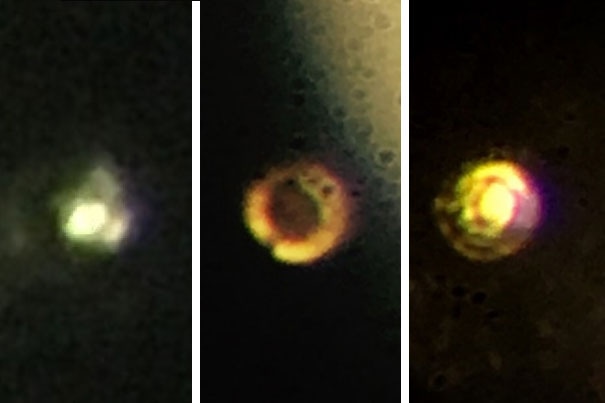Jan 27 2017
 Microscopic images of the stages in the creation of atomic molecular hydrogen: Transparent molecular hydrogen (left) at about 200 GPa, which is converted into black molecular hydrogen, and finally reflective atomic metallic hydrogen at 495 GPa. Courtesy of Isaac Silvera
Microscopic images of the stages in the creation of atomic molecular hydrogen: Transparent molecular hydrogen (left) at about 200 GPa, which is converted into black molecular hydrogen, and finally reflective atomic metallic hydrogen at 495 GPa. Courtesy of Isaac Silvera
Harvard scientists have successfully created the rarest material on the planet, nearly a century after it was theorized. This material could eventually become one of the worlds most valuable.
The material is called atomic metallic hydrogen, and it has long been sought by Issac Silvera, the Thomas D. Calbot Professor of the Natural Sciences, and postdoctoral fellow Ranga Dias. The material will help scientists to answer some fundamental questions about the nature of matter, and it is also theorized that it has a wide range of applications, including a room-temperature superconductor.
The research features in a paper published in Science.
This is the Holy Grail of high-pressure physics. It’s the first-ever sample of metallic hydrogen on Earth, so when you’re looking at it, you’re looking at something that’s never existed before.
Issac Silvera, Harvard
Dias and Silvera squeezed a tiny hydrogen sample at 495 GPa (more than 71.7 million pounds per square inch), which is more than the pressure at the Earths center. Silvera explained that at such extreme pressures solid molecular hydrogen, which consists of molecules on the lattice sites of the solid, breaks down and the tightly bound molecules dissociate and transform into the metal atomic hydrogen.
This research provides an important window to understand the general properties of hydrogen, and hints at new materials with revolutionary potential.
"One prediction that’s very important is metallic hydrogen is predicted to be meta-stable. That means if you take the pressure off, it will stay metallic, similar to the way diamonds form from graphite under intense heat and pressure, but remain diamonds when that pressure and heat are removed." explained Silvera
It is important to understand whether a material is important, as predictions suggest that metallic hydrogen could be used as a superconductor at room temperatures.
Silvera said, "As much as 15 percent of energy is lost to dissipation during transmission, so if you could make wires from this material and use them in the electrical grid, it could change that story."
Dias explained that a room temperature superconductor could change our transportation system, making electric cars more efficient, magnetic levitation of high-speed trains possible, and improving the performance of many electronic devices. The material could also provide major improvements in energy storage and production.
As superconductors have zero resistance, superconducting coils could be employed to store excess energy, which could then be utilized whenever it is required.
Metallic hydrogen could be used as a powerful rocket propellant, to help humans explore the far reaches of space.
It takes a tremendous amount of energy to make metallic hydrogen. And if you convert it back to molecular hydrogen, all that energy is released, so that would make it the most powerful rocket propellant known to man, and could revolutionize rocketry.
Issac Silvera, Harvard
A "specific impluse" (a measure, in seconds, of how fast a propellant is fired from the back of a rocket) of 450 seconds is used to characterize the most powerful fuels in use today. In comparison, the specific impulse of metallic hydrogen is theorized to be 1,700 seconds.
“That would easily allow you to explore the outer planets,” Silvera said. “We would be able to put rockets into orbit with only one stage, versus two, and could send up larger payloads, so it could be very important.”
Silvera and Dias turned to diamond in their experiments, but instead of natural diamond, they used two small pieces of carefully polished synthetic diamond, they then treated them to make it even tougher. The pieces of diamond were mounted opposite each other in a diamond anvil cell.
Diamonds are polished with diamond powder, and that can gouge out carbon from the surface. When we looked at the diamond using atomic force microscopy, we found defects, which could cause it to weaken and break.
Issac Silvera, Harvard
Silvera said that the solution was to use a reactive ion etching process to shave a small layer - just five microns thick, or a tenth of the thickness of a human hair - from the surface of the diamond. The diamond was then coated with a thin alumina layer to prevent the hydrogen from diffusing into the crystal structure and embrittling it.
Silvera said that after more than 40 years of work on metallic hydrogen, and nearly a century since it was first theorized, it was thrilling to see the results.
It was really exciting. Ranga was running the experiment, and we thought we might get there, but when he called me and said, ‘The sample is shining,’ I went running down there, and it was metallic hydrogen. I immediately said we have to make the measurements to confirm it, so we rearranged the lab … and that’s what we did.
Issac Silvera, Harvard
Making metallic hydrogen at Harvard
Harvard University/Youtube.com